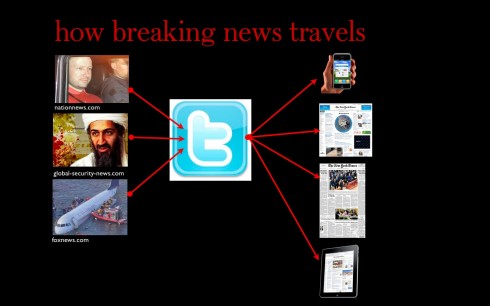TAKEAWAY: How a breaking news story travels today; it begins with a Tweet, and not necessarily one written by a journalist. The challenges of covering breaking news in the age of social media.
It all may start with a Tweet

Recent news breaking events have shown the power of social media, like Twitter, in how the cycle of news first begins. Before the news hits what I call “the media quartet (right of graphic), sometimes users themselves have started the reporting process via Twitter
How a breaking news story travels today is definitely not at all like it used to be. We have recently discussed in this blog the concern of editors and news agencies as they face the challenge of providing the latest news to their readers, but find themselves coming in second to such social media outlets as Twitter and Facebook, among others, and with new ones in the planning stages.
We have said repeatedly that the printed newspaper has lost the time advantage to the digital media.
However, the professional journalists who work with established media—-digital or print—-are realizing that it is Twitter that presents the biggest challenge.
Now an article with the appropriate title, The New, Convoluted Life Cycle of a News Story, gives us a graphic description of what we have observed in such recent breaking news as the landing of a USAirways jetliner in the Hudson River, the death of Michael Jackson, the killing of Bin Laden, and, most recently, the summer massacre of young people at a Norwegian political camp.
According to the article news breaks with a Tweet, followed by a blog post, what the author calls Stage 1. It isn’t until Stage 3 that the more traditional reporting of the story takes place, with quotes and background information. The author of the piece, Lauren Rabaino, writes that:
Newspapers are the only type of publishing company to have the distinct differentiation of “print stories” (which are posted to the web) vs. “blog posts” vs. “web updates” (to the print stories). The different platforms, web CMS and print CMS, have different workflows associated with them.
This piece is must read for all of us , as the author seeks models that will allow for a more cohesive presentation of the story life cycle. However, in my view, the input of readers themselves also provides a challenge. In this piece the discussion centers around how professional journalists handle the cycle of reporting the news. In fact, in some cases, the cycle gets a start NOT with journalists but with readers, the sort of “everyone’s a journalist” idea, which, whether we accept it or not, is a growing reality that is not likely to disappear anytime soon.
In some cases that Stage 1 Twitter introduction to the breaking news is created by readers themselves, which means that Stage 3 (the more professional version of the story) needs to come in sooner.
Of related interest:
-The marketing of our profession
https://garciamedia.com/blog/articles/the_marketing_of_our_profession/